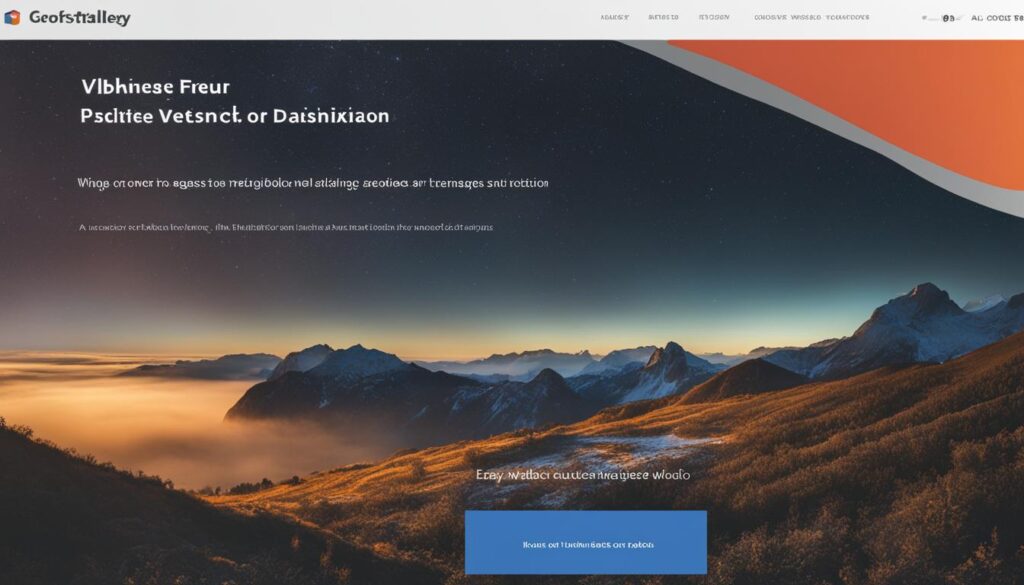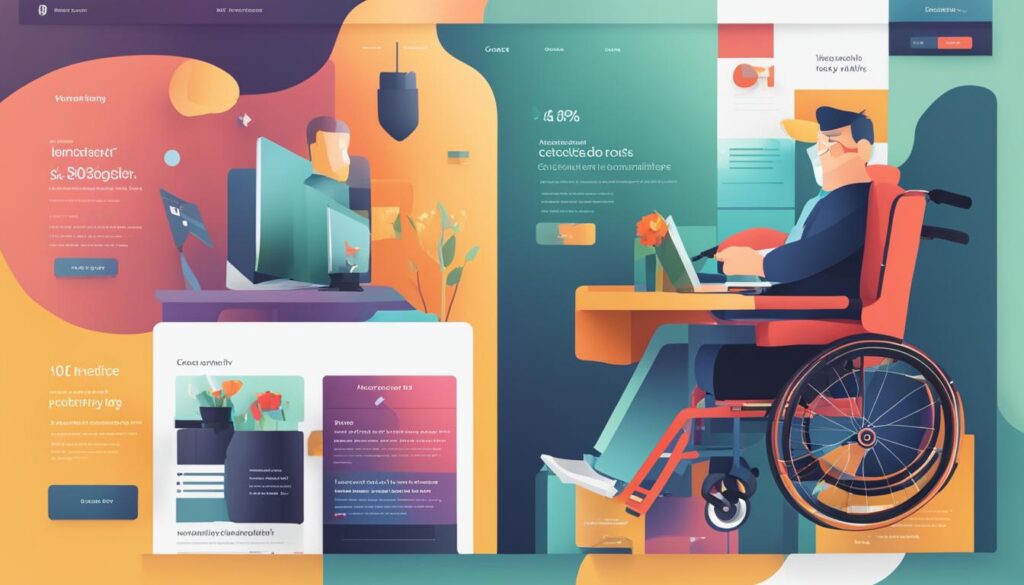Welcome to WebsiteDesigner.Business, where we believe in creating web experiences that empower individuals of all abilities. In today’s digital age, it is essential to design websites that are accessible to everyone, regardless of their disabilities. Our team of accessibility experts is dedicated to making the internet a more inclusive space.
When it comes to web design, accessibility is key. It is about ensuring that everyone can access and engage with digital content, regardless of their abilities. By implementing inclusive web design practices, we can create user-friendly websites that cater to a diverse range of users.
At WebsiteDesigner.Business, we understand the significance of accessible web design. It goes beyond meeting basic requirements; it is about creating equal opportunities for individuals with disabilities to participate fully in the digital world. Our goal is to help you design websites that adhere to web accessibility guidelines and meet ADA compliance and WCAG 2.1 standards.
Key Takeaways:
- Web design plays a crucial role in creating an inclusive online experience for all individuals
- Accessibility in web design goes beyond catering to individuals with permanent disabilities
- Practical tips for creating an accessible website include keeping layouts clean and minimal, using color wisely, providing descriptive alt text, metadata, and links, and maintaining design consistency
- Accessible web design expands audience reach, improves search engine rankings, reduces maintenance costs, and increases brand reputation
- Embracing inclusive design and accessibility leads to a wider market reach, enhanced user experiences, compliance with legal requirements, and a positive brand perception
The Significance of Accessibility in Web Design
When it comes to web design, accessibility is paramount. It goes beyond catering to individuals with permanent disabilities and extends to a broader range of users with diverse needs. Temporary disabilities, varying levels of ability, limited internet access, and mobile browsing are all factors to consider. By designing with empathy and inclusivity in mind, we ensure that all users can access and navigate websites seamlessly.
To achieve this, it is essential to follow web accessibility guidelines such as ADA compliance and WCAG 2.1 standards. ADA compliant website design ensures that websites are accessible to individuals with disabilities, in accordance with the Americans with Disabilities Act. WCAG 2.1 standards provide a comprehensive framework for creating accessible web content, including guidelines for text alternatives, color contrast, keyboard accessibility, and more.
“Accessibility is not only about complying with regulations; it is about creating an inclusive online environment where all users can participate fully.”
The Benefits of Accessibility in Web Design
Designing websites with accessibility in mind brings numerous benefits. Not only does it empower individuals with disabilities by granting them equal access and opportunities, but it also enhances the overall user experience for all users. When websites are designed with accessibility in mind, they become more usable, intuitive, and inclusive. Users with varying abilities can navigate and interact with the content effortlessly. Additionally, embracing accessibility can lead to higher search engine rankings, increased user engagement, and a wider audience reach.
An Inclusive Online Environment
Creating an inclusive online environment is our responsibility as web designers and developers. It is about ensuring that websites are accessible to everyone, regardless of their abilities or limitations. By adhering to web accessibility guidelines, we can break down barriers and provide equal opportunities for all individuals, creating a more inclusive digital landscape.
Practical Tips for Creating an Accessible Website

When it comes to web design, creating an accessible website is paramount. By implementing user-friendly web design practices and inclusive design principles, we can ensure that our websites are accessible to all users, regardless of their abilities. In this section, we will explore some practical tips to help you create an inclusive and user-friendly website.
Keep Layouts Clean and Minimal
Clutter-free layouts are essential for creating an accessible website. By keeping the design clean and minimal, users can easily navigate and comprehend the content. Avoid overwhelming the page with excessive elements or unnecessary distractions.
Use Color Wisely
Color plays a crucial role in web design, but it can also impact accessibility. Ensure that there is enough contrast between text and background colors to make the content legible for all users. Additionally, provide alternative options, such as underlined text or bold highlighting, to differentiate important information.
Provide Descriptive Alt Text, Captions, and Clear Hyperlinks
Descriptive alt text is crucial for users who rely on screen readers to access website content. It provides a textual description of images, allowing visually impaired users to understand the context. Additionally, captions for videos and multimedia content, along with clear hyperlinks, enhance both user experience and search engine optimization.
Maintain Consistency in Design
Consistency is key when designing an accessible website. By using consistent design patterns throughout the website, users can navigate with ease and confidence. This includes maintaining consistent navigation menus, button styles, and typography. A consistent design ensures a more inclusive and user-friendly experience.
Summary
To create an accessible website, it is crucial to follow user-friendly web design practices and inclusive design principles. By keeping layouts clean and minimal, using color wisely, providing descriptive alt text, captions, and clear hyperlinks, and maintaining consistency in design, we can ensure that our websites are accessible to all users. Let’s strive to make the web a more inclusive and user-friendly space for everyone.
Benefits of Accessible Web Design
Implementing accessible design principles not only expands the audience reach but also improves search engine rankings, reduces maintenance costs, and increases audience engagement. By making websites accessible to all, we create a more inclusive online presence and reap the benefits that come with it.
Improves search engine rankings: Search engines prioritize user-friendly and accessible websites in their rankings. By following web accessibility guidelines and implementing inclusive design practices, we enhance the user experience and signal to search engines that our website is accessible and user-friendly.
Reduces maintenance costs: Accessible websites are built with clean and structured code, making them easier to maintain and update. By adhering to accessibility standards and guidelines, we ensure that our website remains compatible with evolving technologies, minimizing the need for constant updates and reducing maintenance costs.
Increases audience reach: An accessible website reaches a wider audience, including individuals with disabilities and diverse abilities. By designing our website to be inclusive and user-friendly, we not only cater to these users but also expand our potential customer base, attracting more visitors and driving more conversions.
Accessible web design has a far-reaching impact, extending beyond improving user experience for individuals with disabilities. It benefits all users, improves search engine visibility, and reduces long-term maintenance costs. By developing an accessible website, we demonstrate our commitment to inclusivity and ensure a positive online experience for everyone.
Let’s dive deeper into the benefits of accessible web design with a comprehensive table that showcases the advantages.
| Benefits of Accessible Web Design |
|---|
| Improved search engine rankings |
| Reduced maintenance costs |
| Increased audience reach |
The Importance of Designing for Legal Compliance

Designing an accessible website is not only the right thing to do but also essential for legal compliance. The Department of Justice requires business websites to align with specific accessibility standards. Non-compliance can lead to potential lawsuits, putting businesses at risk. Partnering with accessibility solutions like accessiBe ensures compliance with WCAG, ADA, and other accessibility regulations, and provides continuous monitoring and personalized reports.
“Designing an accessible website is not an option; it is a legal obligation that businesses must fulfill.”
Web accessibility has become a legal requirement to ensure equal rights and opportunities for all individuals. The Americans with Disabilities Act (ADA) sets the standard for website accessibility and enforces compliance to create an inclusive online experience. Websites that fail to meet these standards face the risk of legal action and potential penalties.
Ensuring Compliance with WCAG and ADA
The Web Content Accessibility Guidelines (WCAG) offer a comprehensive set of guidelines for creating accessible websites. These guidelines address various aspects of accessibility, including perceivability, operability, understandability, and robustness. ADA compliance refers to conforming to the accessibility standards set by the ADA.
By partnering with accessiBe, businesses can confidently ensure compliance with both WCAG and ADA. AccessiBe’s AI-powered accessibility solution automates website adjustments and provides ongoing monitoring to maintain compliance. This includes features such as screen-reader optimization, keyboard navigation, color contrast adjustments, and alternative text for images.
The Benefits of Designing for Legal Compliance
Creating an ADA compliant and WCAG conforming website not only helps businesses avoid legal complications but also offers a range of additional benefits:
- Expanded Audience: An accessible website reaches and engages a wider audience, including individuals with disabilities who make up a significant portion of the population.
- Improved User Experience: Accessible design enhances usability for all users, making navigation easier and content more understandable.
- Positive Brand Image: Demonstrating a commitment to inclusivity and accessibility helps build a positive brand perception and fosters trust among users.
- Boosted SEO: ADA compliance and WCAG adherence improve website performance and SEO rankings, leading to increased organic traffic.
| Benefits | Explanation |
|---|---|
| Expanded Audience | An accessible website reaches a wider audience, increasing potential customers. |
| Improved User Experience | Accessible design enhances usability and user satisfaction. |
| Positive Brand Image | Commitment to inclusivity builds trust and loyalty among customers. |
| Boosted SEO | ADA compliance and WCAG adherence improve search engine rankings. |
By designing websites for legal compliance, businesses demonstrate a commitment to inclusivity and accessibility while reaping the benefits of reaching a larger audience, enhancing user experiences, building a positive brand image, and improving SEO rankings.
Understanding Inclusive Design and Accessibility

Inclusive design is a fundamental approach that places the needs of diverse users at the forefront of product development. It goes beyond catering to a specific group and instead integrates accessibility features and considerations into the core design and functionality. By doing so, we create a seamless user experience that caters to individuals of all abilities.
Accessibility is instrumental in promoting inclusivity and equal opportunities. It focuses on designing products and services that accommodate the needs of users with disabilities. Whether it’s implementing alternative text for images, providing closed captions for videos, or ensuring keyboard navigation for those who cannot use a mouse, accessibility is about breaking down barriers and enabling everyone to access and interact with digital content.
At our core, we believe in the power of innovation and technology to drive positive change. By integrating inclusive design and accessibility into our web design processes, we strive to create products that are inclusive, user-friendly, and experience-enhancing for individuals of all abilities.
“Accessibility is not an optional add-on; it is a fundamental pillar of inclusive design that fosters equal access for all.”
The Impact of Inclusive Design and Accessibility
By embracing inclusive design and accessibility, we open doors to new possibilities and unlock the potential for growth:
- Expanded reach: Inclusive design allows us to tap into a wider market segment, reaching individuals who might otherwise be excluded. When our products are accessible to all, we maximize our audience reach and create opportunities for engagement and growth.
- Improved user experiences: Prioritizing inclusivity and accessibility leads to enhanced user experiences. By considering the diverse needs of our users, we can create products that are more intuitive, easier to navigate, and ultimately provide a better overall experience.
- Compliance with legal requirements: Inclusive design and accessibility are not just ethical choices but also legal obligations. By adhering to accessibility standards such as the Web Content Accessibility Guidelines (WCAG), we ensure compliance with relevant regulations and mitigate the risk of potential legal challenges.
- Enhanced brand perception: When we prioritize inclusivity and accessibility, we demonstrate our commitment to social responsibility and equality. This fosters a positive brand perception, reinforcing trust and loyalty among our customers and stakeholders.
By embracing inclusive design and accessibility, we not only create a more inclusive and equitable digital landscape but also unlock new opportunities for our business. Together, let’s build a future where technology is accessible to all.
Benefits of Embracing Inclusive Design and Accessibility

Embracing inclusive design and accessibility has numerous benefits. It not only opens up new market segments but also expands the customer base, allowing businesses to connect with a wider audience. By prioritizing inclusivity, products and services become more accessible and intuitive, leading to enhanced user experiences. Users will find it easier to navigate websites, applications, and digital platforms, making their interactions seamless and enjoyable.
“Inclusivity involves valuing everyone equally and ensuring equal access and opportunities.”
Moreover, embracing inclusive design is crucial for compliance with legal requirements and standards. By designing with accessibility in mind, businesses mitigate the risk of potential legal challenges, such as lawsuits for non-compliance. Compliance not only safeguards against legal consequences but also demonstrates a commitment to inclusivity, enhancing brand perception and reputation.
Ultimately, embracing inclusive design and accessibility is a win-win situation. It expands market reach, improves user experiences, ensures legal compliance, and strengthens brand reputation. By making products and services accessible to all, businesses create a more inclusive and welcoming environment, fostering positive connections with their target audience.
Strategies for Implementing Inclusive Design and Accessibility
Implementing inclusive design and accessibility requires a collaborative and iterative approach. By engaging with diverse user groups, collaborating with accessibility experts, and continuously gathering and implementing user feedback, we can create products that meet the needs of all users. Here are key strategies to consider:
- User Research and Testing: Conduct extensive user research to gain insights into the needs and pain points of diverse users. Usability testing helps identify potential barriers and areas for improvement. By understanding user perspectives, we can make informed design decisions that prioritize accessibility.
- Collaboration with Accessibility Experts: Work closely with accessibility experts to ensure compliance with relevant standards such as ADA and WCAG. Accessibility experts bring deep knowledge and expertise in making designs accessible to users with disabilities. Their guidance ensures that accessibility is embedded throughout the design process, leading to more inclusive products.
- Continuous Improvement: Iterate and refine product designs based on user feedback. Regularly collect feedback from users, both with and without disabilities, to identify potential accessibility issues and make necessary improvements. This iterative approach allows us to create products that evolve with changing needs and technologies.
Education and Training:
Educate and train all team members on inclusive design principles and accessibility guidelines. Foster a culture of inclusivity within the organization by providing resources, workshops, and training sessions. By equipping team members with the knowledge and skills to implement inclusive design practices, we empower them to create accessible products that benefit all users.
“Inclusive design and accessibility cannot be an afterthought. It requires intentional collaboration, user-centric approaches, and a commitment to continuous improvement. By engaging with diverse user groups, working closely with accessibility experts, and iterating based on user feedback, we can create digital experiences that truly include and empower all.” – [Author Name]
Remember, accessibility is a journey, and it is our responsibility to make the online world a more inclusive place. By implementing these strategies, we can ensure that our products are accessible to everyone, regardless of their abilities.
Conclusion
Inclusive design and accessibility are fundamental in creating a digital landscape that caters to everyone. At WebsiteDesigner.Business, we prioritize accessibility in our web design services to empower individuals with disabilities and ensure equal access and opportunities for all. By embracing inclusive design principles, we not only create a user-friendly experience but also expand our market reach and comply with legal requirements.
Designing for accessibility opens up new possibilities, allowing us to reach a wider audience and enhance user experiences. By making our websites more inclusive, we ensure that every user can navigate and interact with our digital content seamlessly. This not only benefits individuals with disabilities but also improves search engine rankings and reduces maintenance costs.
Let us come together to forge a digital landscape that is accessible to all. Order a web design plan on our website today to make your website more inclusive and ensure it complies with accessibility standards. Together, we can create a digital environment that values diversity, inclusivity, and equal opportunities for everyone.
FAQ
What is web design for accessibility?
Web design for accessibility refers to the practice of creating websites that are inclusive and user-friendly for individuals of all abilities. It involves designing with empathy and considering the needs of users with disabilities, temporary limitations, varying levels of ability, limited internet access, and mobile browsing.
Why is accessibility important in web design?
Accessibility in web design ensures that everyone, regardless of their abilities, can access and engage with digital content. It promotes inclusivity, equal opportunities, and a positive user experience for all users. It also helps websites comply with web accessibility guidelines such as ADA (Americans with Disabilities Act) compliance and WCAG (Web Content Accessibility Guidelines) 2.1 standards.
What are some practical tips for creating an accessible website?
Some practical tips for creating an accessible website include keeping the layout clean and minimal, using color wisely, providing descriptive alt text, metadata, and links, and maintaining consistency in design. A clutter-free layout and high contrast elements improve comprehension and interaction. Descriptive alt text, captions, and clear hyperlinks enhance user experience and search engine optimization. Consistency in design patterns ensures a more inclusive and user-friendly experience.
What are the benefits of accessible web design?
Accessible web design expands the audience reach, improves search engine rankings, reduces maintenance costs, and increases user engagement. Websites that are accessible to all perform better in search engine rankings, reach a wider audience, and save on maintenance costs. Accessible design also leads to a more inclusive and user-friendly experience, enhancing brand perception and reputation.
Why is it important to design websites for legal compliance?
Designing websites for legal compliance, such as WCAG and ADA compliance, is essential to avoid potential lawsuits and legal challenges. The Department of Justice requires business websites to align with specific accessibility standards, and non-compliance can put businesses at risk. Partnering with accessibility solutions like accessiBe ensures compliance with relevant accessibility regulations and provides continuous monitoring and personalized reports.
What is inclusive design and accessibility?
Inclusive design and accessibility prioritize the needs of diverse users from the onset of product development. It integrates accessibility features and considerations into the core design and functionality, creating a seamless user experience for individuals of all abilities. Inclusive design focuses on accommodating the needs of users with disabilities, promoting inclusivity and equal opportunities.
What are the benefits of embracing inclusive design and accessibility?
Embracing inclusive design and accessibility opens up new market segments, expands the customer base, and leads to improved user experiences. It makes products more intuitive and easier to use, ensuring compliance with legal requirements and standards, and mitigating the risk of potential legal challenges. Prioritizing inclusivity and accessibility enhances brand perception and reputation.
What strategies can be used to implement inclusive design and accessibility?
Implementing inclusive design and accessibility involves engaging with diverse user groups, working closely with accessibility experts, and continuously iterating and improving products based on user feedback. User research and testing provide insights into user needs and pain points. Collaboration with accessibility experts ensures compliance with relevant standards. Education and training foster a culture of inclusivity within the organization.
How does web design for accessibility empower individuals?
Web design for accessibility empowers individuals with disabilities by providing them equal access and opportunities online. By prioritizing accessibility, we create a digital landscape that serves everyone, regardless of their abilities. Accessible websites allow individuals to navigate and interact with online content seamlessly, ensuring an inclusive online presence for all.

Leave a Reply